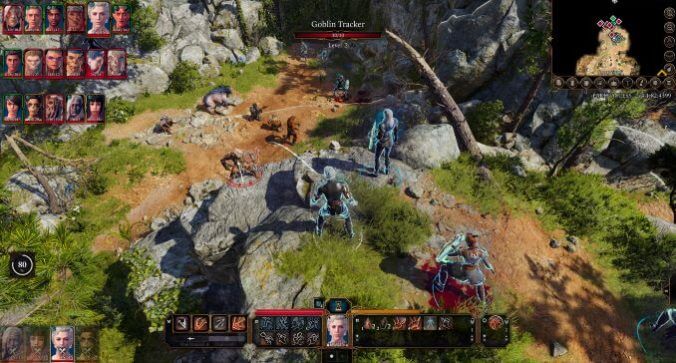Baldur’s Gate 3 is in a curious position. It is the only (major) videogame project to base itself on Dungeons & Dragons’ fifth edition, by far the tabletop game’s most popular incarnation. It is coming out just a few months after the property’s first successful (and moderately enjoyable, like butter on toasted white bread) swing into Hollywood. It is also the first big budget RPG of its kind since developer Larian’s last release, the excellent Divinity: Original Sin 2.
All this is to say, Baldur’s Gate 3 is perhaps unfairly burdened. Nearly a decade’s worth of discourse about fifth edition is bearing down on it. It’s being released while the IP (ugh) lays the groundwork for something approaching mainstream acceptance. Legions of starved Bioware freaks will buy this game to tide them over before the forever teased Dragon Age: Dreadwolf and whatever that Mass Effect project is. Additionally, Baldur’s Gate 3‘s scale practically ensures good press, which in turn ensures backlash. A lot of people have a lot of expectations about what this game is going to be.
I’m only around 10 hours into the release version of Baldur’s Gate 3 and I can tell that it is going to disappoint a lot of people. It’s also frightfully good. As reported, it is Larian’s big swing at a cinematic RPG a la Bioware, while holding stubbornly and admirably to the genre’s number crunched origins. Yet, that description does undersell it. It’s not exactly subversive or surprising. However, at least thus far, it is assured. It’s determined to pull on DnD’s vast reserves of lore bullshit to construct expressive and interesting scenarios, both tactical and emotional.
As for plot, it’s about a merry band of adventurers brought together by grim fate. You have been kidnapped by the eldritch Mind Flayers, who have infected you, along with most of the party members, with mystical tadpoles. At some future date, you will all become tentacle-faced, mind-eating monsters yourselves. Thanks to a massive battle between the Flayers and their dragon-riding enemies, the Githyanki, you and the others manage to escape, but must find a cure for the creature growing in your head.
You can play as most of the potential party members, or create a character of your own. I picked the Dark Urge background, which offers some of the narrative perks of playing as a predefined character, while still letting you customize your class and appearance. Pure custom characters choose a background, which gives them special responses and specific events. Combat is turn-based and operates somewhat faithfully inside Dungeons & Dragons’ basic ruleset. Each turn, you’ll roll initiative, move your character around, perform an action like attacking with your weapon or throwing a rock or casting a spell. Different spells and weapons deal varying kinds of damage, which can help or hurt your attempts to vanquish enemies. Within these constraints there’s a serious amount of wackiness. Throw oil on the floor and set it on fire, push enemies off of cliffs, etc.
Some of Divinity: Original Sin 2‘s tactical bite is absent here. For example, I appreciated in Divinity that spells and attacks basically always land. That game always asks “what” and “when” and “from how far away” rather than “will this hit?” Whiffing on a major attack never feels good. The single action per turn can also feel limiting in comparison to Divinity‘s expansive potential turns. However, these are minor complaints. The single action also gives each turn some weight. Battles are tipped against you, early on especially, so every move can count for something. The encounter design, at least thus far, is top notch. Most environments offer specific strategies and challenges. Various party compositions feel viable and all are given opportunities for interesting play. It’s tempting to replay fights with a different party loadout, just to see what will happen.

Outside of combat, you can sneak around, unlock chests or doors, and talk to other characters, which can involve any number of dice rolls to persuade. As you explore, you will also perform passive checks, which can let you see traps before they trigger or catch hiding enemies. Thankfully, Baldur’s Gate 3 surfaces all of its dice rolls, whether in the combat log or dramatic dice roll animations during dialogue. It lends a bit of verve and drama to what can feel often arbitrary in computer RPGs. Like in DnD proper, exploration is not as fleshed out or as interesting as fighting. However, Gate does a great job at surfacing the right decisions and considerations
It’s weird to say, because in practice there have been so few fifth edition videogames, but the system feels far more suited to this digital incarnation than any casual role-playing group. My dozens of hours in 5e at the table resulted mostly in tedium. I also think DnD is appallingly limited for actual play (a genre of podcast or livestream where you watch nerds play tabletop games). Small wonder that is it is the most popular role-playing game in the world, as it is bad at doing most of the things a casual player would want it to. A computer cuts out most of the tedious number management and mostly enforces DnD’s most interesting rules. The interface is effective at clearly rendering your options. I have sometimes felt overwhelmed, but I have rarely felt burdened by choice.
All that said however, Baldur’s Gate 3 is still Dungeons & Dungeons. If your distaste for that is immense enough, it is unlikely to coax you into enjoyment. Additionally, while the game does offer help tutorials, it assumes familiarity with DnD’s basic systems. Newcomers might find this difficult to wade through. It can even be tough for more seasoned players. Not having the shape of the entire system in your head can make it difficult to make decisions upon leveling up, especially if you are interested in multiclassing. If you want to min-max, you are going to have to consult outside literature. To be fair though, the game’s “Balanced” difficulty has served me well here. I’ve made character decisions mostly along character-driven, role-playing lines and have found just the right amount of tactical difficulty. The game is also generous with saves, so it’s easy to reload and try again if you struggle with a fight or if a roll doesn’t go your way (though I would recommend taking your lumps at least some of the time).
As for more abstract role-playing concerns, Baldur’s Gate 3 smartly does away with DnD’s tedious systems of alignment, along axes of chaos to lawful and good to evil. While the game allows ludicrous villainy, most of its choices are not really moral (at least in the limited way that computer role-playing has traditionally understood morality). Rather, they are social. The game grants Inspiration points when you act in accordance with your character or your party members. This system means you are primarily incentivized to role-play and to please your companions. Choices like “burning down the orphanage” are alternatives to the principle decisions of the game, rather than central fixtures. The game is primarily interested in putting you in uncomfortable or uneasy situations, where every choice made closes some future door, and figuring out what your fantasy character would do. It feels expressive, rather than judgmental.
This social negotiation extends to your party. You travel with other characters not because you get along, but because you have a shared affliction and shared goals. Your relationships feel nicely, if crudely, shaped by your choices and whether your party members approve of them. It’s easy to reduce your crew to an assortment of genre clichés. A cocky mage, an extravagant rogue, a noble but tortured Warlock. While I’m frankly not far enough to know for sure, I feel pretty confident that there is more below the surface. For example, the Githyanki fighter Lae’zel radiates authority, but among her kin she is just another soldier, resolute, but lowly. Again, every situation is a social negotiation with which you and your party interact. Some of your party members might also know more than you. The amount of proper nouns and big ideas Baldur’s Gate 3 throws around is immense, but it is in service of regular human drama.
The shape of discourse is impossible to determine; we will likely only know what people actually think of Baldur’s Gate 3 years from now. However, the reception so far has been broadly split into two camps. The first is “wow this game is big and it lets you do so much!” This is technically true, but is not very effective criticism. A game’s limitations are where it most vividly expresses its priorities, even in something as big as this.
The second camp is a frustration that it doesn’t do more or that it isn’t like other RPGs that work with different systems. Baldur’s Gate 3 is not Disco Elysium, though it takes a few cues from it. It is not, despite my allusion earlier, a Bioware RPG. It cannot do everything, nor should it. When we talk about what something should be, rather than what it is, we are not doing criticism. We are writing fan fiction. Its scale and its roots in tabletop might pitch something that it, by definition, cannot offer. I do not think it is fair to hold that against it. Baldur’s Gate 3 is not modest, but it is focused. I’m excited to find out what it wants me to keep my eye on.
Grace Benfell is a queer woman, critic, and aspiring fan fiction author. She writes on her blog Grace in the Machine and can be found @grace_machine on Twitter.

